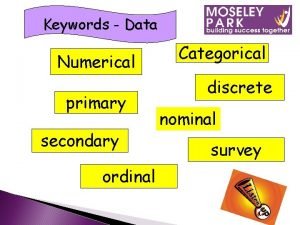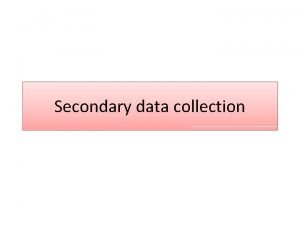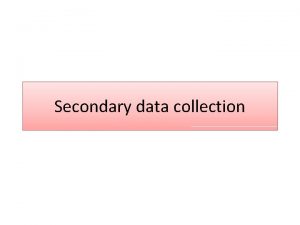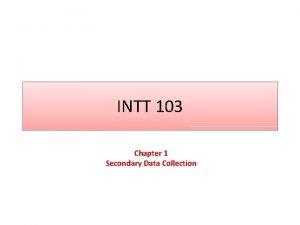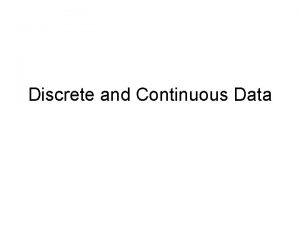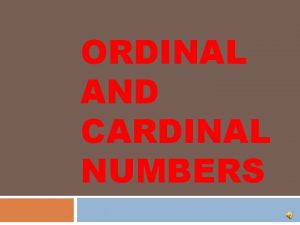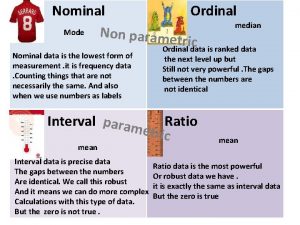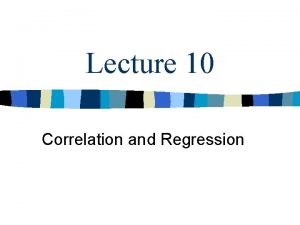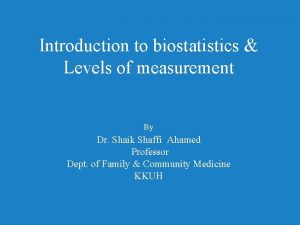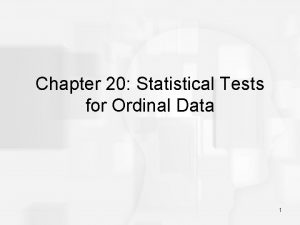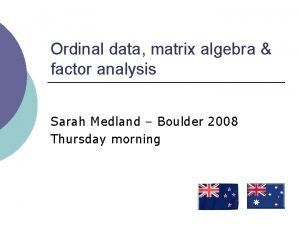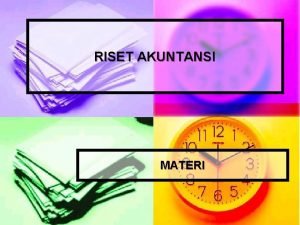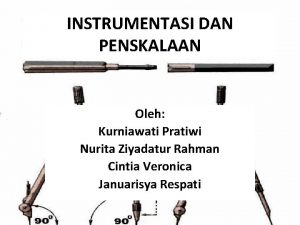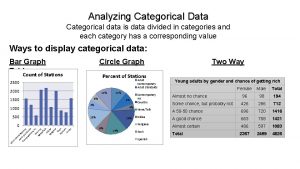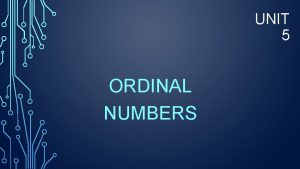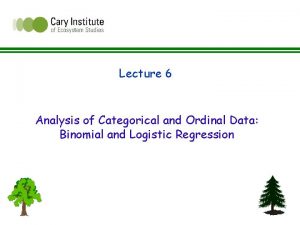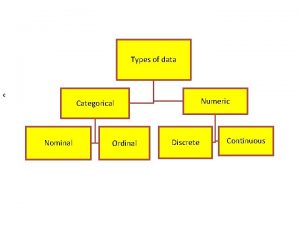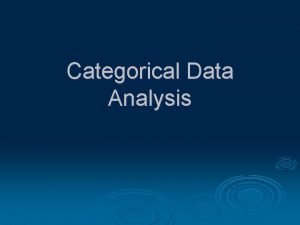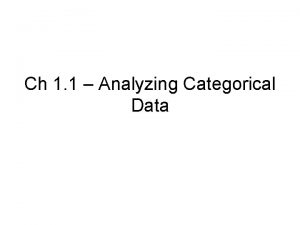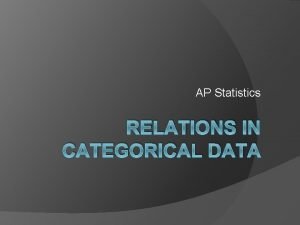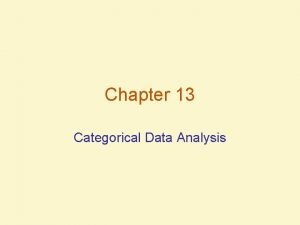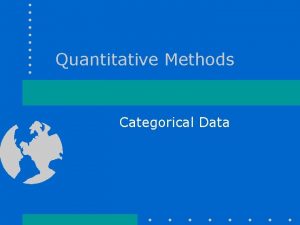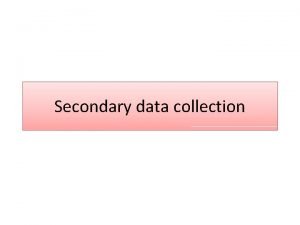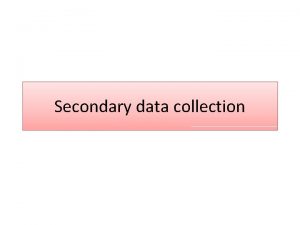Keywords Data Numerical primary secondary ordinal Categorical discrete




















- Slides: 20

Keywords - Data Numerical primary secondary ordinal Categorical discrete nominal survey

Stratified Types. Sampling. of Data 27/02/2021 Learning Objective: Today we will look at the different types of data and how to group this data effectively. Key words: Qualitative (categorical), Quantitative (numerical), Discrete, Continuous, Ordinal, Nominal, Bi-variate, Primary, Secondary.

WHAT IS Data � Data are the actual pieces of information that you collect through your study. � For example, if you ask five of your friends how many pets they own, they might give you the following data: 0, 2, 1, 4, 18. (The fifth friend might count each of her aquarium fish as a separate pet. ) � Not all data are numbers; let’s say you also record the gender of each of your friends, getting the following data: male, female, female.

Types of Data When you are faced with data, either that you have collected or that you have sourced from elsewhere, you need to know what kind of data it is to represent it properly. For example, will we be able to show it in a pie chart or a scatter graph?

Types of Data � Data can be divided into two basic types 1) Numerical data sets (also called quantitative data) 2) Categorical data sets (also called qualitative data)

NUMERICAL Data � These are data sets that consist of numerical values � There are 2 types of numerical data 1) Discrete data – Data that can only take certain values. (mostly whole numbers or clearly distinct values) For example: the number of students in a class (you can't have half a student). 2) Continuous data - Data that can take any value (within a range - can include all decimal values within range) Example: People's heights could be any value (within the range of human heights), not just certain fixed heights.

� Discrete data is counted, Continuous data is measured


CATEGORICAL Data � These are data sets where the data consists of categories or descriptive terms � Again, 1) there are 2 types Nominal - A type of categorical data in which objects fall into unordered categories. Examples: � Hair color – blonde, brown, red, black, etc. � Race – Caucasian, African, Asian, etc. � Smoking status – smoker, non-smoker

Ordinal Data - A type of categorical data in which order is important Examples: � Class – year 7, year 8, year 9 etc � Degree of illness – none, mild, moderate, severe � Opinion of students about homework– ticked off, neutral, enjoy it 2)


� Binary Data • A type of categorical data in which there are only g two categories. • Binary data can either be nominal or ordinal Examples: � Smoking status – smoker, non smoker � Attendance – present, absent � Class – lower classman, upper classman

Task One On your desk are the key words you need to know when looking at types of data. You need to cut out the key words, and match them to the definition. EXTENSION: What diagrams could you use to show each piece of data?


Types of Data Cheryl is checking entry forms at a horse and pony show. The form asks for the gender of the horse, its age, and its colour. State whether each of the variables on the form is numerical, categorical, discrete or continuous.

Task Two Put a title in your book called qualitative data, and another called quantitative data. Cut out each of the statements and stick them under the correct heading. Now choose two different colours. Colour all the discrete data in one colour and all the continuous data in another colour.


Primary vs. Secondary Data Primary Data collected by the researcher. Methods of collecting data can be expensive and timeconsuming, but the researcher can obtain exactly the right data for their purposes. The data will be trustworthy since the researcher knows who has collected it and that there was no bias. This can be collected via survey’s or observation List two different advantages and two different disadvantages of primary data.

Secondary Data � Data collected by someone else and then sourced by you. The internet can be a good way to do this.

EXTENSION: The table shows the number of people in each age group who watched a synchronised swimming event. Age Group 0 -16 17 -29 30 -44 45 -59 60+ Number of people 86 123 365 274 52 A survey uses a stratified sample of 50 spectators. Work out the number from each age group in the sample.
 Numerical data examples
Numerical data examples Asu
Asu Nominal, ordinal, discrete, continuous
Nominal, ordinal, discrete, continuous Primary data and secondary data
Primary data and secondary data Secondary data
Secondary data Data collection procedure example
Data collection procedure example Primary data in statistics
Primary data in statistics Primary data and secondary data
Primary data and secondary data Interval scale example in research
Interval scale example in research Data augmentation numerical data
Data augmentation numerical data Discrete vs continuous examples
Discrete vs continuous examples Ordinal data
Ordinal data Ordinal vs. cardinal
Ordinal vs. cardinal Nominal vs ordinal data
Nominal vs ordinal data Correlation for ordinal data
Correlation for ordinal data Scale ordinal nominal
Scale ordinal nominal Statistical tests for ordinal data
Statistical tests for ordinal data Factor analysis ordinal data
Factor analysis ordinal data Ordinal adalah
Ordinal adalah Skala interval
Skala interval Data ordinal adalah
Data ordinal adalah
